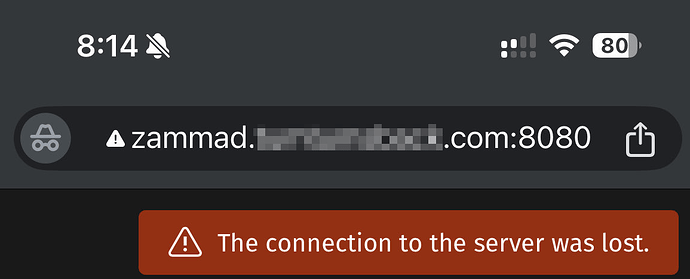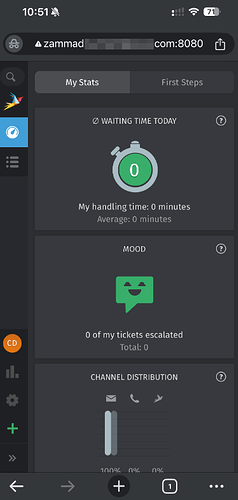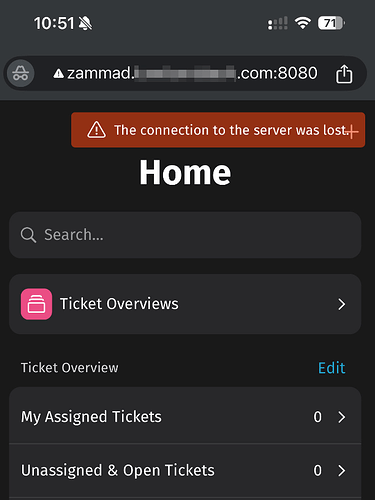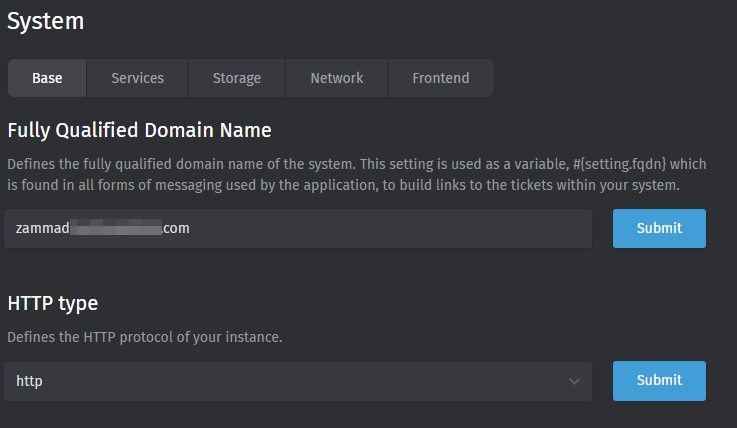Infos:
- Used Zammad version: 6.4.0
- Used Zammad installation type: (source, package, docker-compose, …): Portainer Deployment (Docker)
- Operating system: Base OS is Ubuntu 24.04.1 LTS
- Browser + version: Multiple, but for instance, Chrome 131.0.6778.73 on iOS
Expected behavior:
Want to be able to respond to tickets via Mobile.
Actual behavior:
On mobile, ‘The connection to the server was lost’ message in the top right corner. Can’t do things like respond to tickets, etc.
I really have done no special configurations to the portainer deployment itself. I set the following variables on the nginx container:
NGINX_SERVER_NAME (gave it the proper FQDN [zammad.(mydomainisactuallyhere).com])
NGINX_SERVER_SCHEME (http) - I’ve experimented with both http and https, no difference there. I think http is proper in my deployment, as I have SSL termination happening upstream.
And, that’s it. I’ve done my searching/research, I’ve seen a lot of the articles talking about making sure the /cable location in the nginx conf is properly coded – but in a lot of those cases, those are people upgrading from a pre-6.0 version… This is a brand new 6.4.0 deployment and so that /cable location section in the server block looks perfectly fine. Not sure where else to begin looking.
Here is the running ‘default’ nginx conf within ‘sites-enabled’
$ cat default
#
# this is an example nginx config for Zammad
# Please visit https://docs.zammad.org for further input on how to configure
# your nginx to work with Zammad
#
# This is a NON SSL configuration, DO NOT use in production!
#
upstream zammad-railsserver {
server zammad-railsserver:3000;
}
upstream zammad-websocket {
server zammad-websocket:6042;
}
server {
listen 8080;
listen [::]:8080;
# replace 'localhost' with your fqdn if you want to use zammad from remote
server_name zammad.[mydomainisactuallyhere].com;
# security - prevent information disclosure about server version
server_tokens off;
root /opt/zammad/public;
access_log /dev/stdout;
error_log /dev/stdout;
client_max_body_size 50M;
location ~ ^/(assets/|robots.txt|humans.txt|favicon.ico|apple-touch-icon.png) {
expires max;
}
# legacy web socket server
location /ws {
proxy_http_version 1.1;
proxy_set_header Upgrade $http_upgrade;
proxy_set_header Connection "Upgrade";
proxy_set_header CLIENT_IP $remote_addr;
proxy_set_header X-Forwarded-For $proxy_add_x_forwarded_for;
proxy_set_header X-Forwarded-Proto http;
proxy_read_timeout 86400;
proxy_pass http://zammad-websocket;
}
# action cable
location /cable {
proxy_http_version 1.1;
proxy_set_header Upgrade $http_upgrade;
proxy_set_header Connection "Upgrade";
proxy_set_header CLIENT_IP $remote_addr;
proxy_set_header X-Forwarded-For $proxy_add_x_forwarded_for;
proxy_set_header X-Forwarded-Proto http;
proxy_read_timeout 86400;
proxy_pass http://zammad-railsserver;
}
location / {
proxy_set_header Host $http_host;
proxy_set_header CLIENT_IP $remote_addr;
proxy_set_header X-Forwarded-For $proxy_add_x_forwarded_for;
proxy_set_header X-Forwarded-Proto http;
# Change this line in an SSO setup
proxy_set_header X-Forwarded-User "";
proxy_read_timeout 300;
proxy_pass http://zammad-railsserver;
gzip on;
gzip_types text/plain text/xml text/css image/svg+xml application/javascript application/x-javascript application/json application/xml;
gzip_proxied any;
}
}
Steps to reproduce the behavior:
Simply just load the webpage.




